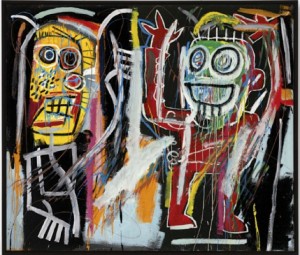 Media and blogs are filled with debates about raising the minimum wage to $10.10/hr (federal) or $15.00/hr (local). Conservatives argue that paying such prodigious sums to workers who sweep floors, fry burgers, and empty bedpans would end life on this planet as we know it.
Media and blogs are filled with debates about raising the minimum wage to $10.10/hr (federal) or $15.00/hr (local). Conservatives argue that paying such prodigious sums to workers who sweep floors, fry burgers, and empty bedpans would end life on this planet as we know it.
In May 2013, the media reported that Christie’s, the famous New York auction house, sold the Jean-Michel Basquiat painting pictured here, which Christie’s catalog described as “acrylic, oilstick, spray enamel and metallic paint on canvas,” for $48.8 million to an undisclosed buyer.
Never heard of Basquiat? Neither had I. According to Wikipedia, he was a Brooklyn-born Haitian-American artist whose “art focused on ‘suggestive dichotomies,’ such as wealth versus poverty, integration versus segregation, and inner versus outer experience” and “appropriated poetry, drawing and painting, and married text and image, abstraction and figuration, and historical information mixed with contemporary critique.” Furthermore, he “used social commentary in his paintings as a ‘springboard to deeper truths about the individual’, as well as attacks on power structures and systems of racism, while his poetics were acutely political and direct in their criticism of colonialism and support for class struggle.”
If you’re wondering what “spray enamel” is, that’s the paint that comes in spray cans you buy in hardware stores which is widely used by graffiti vandals to “tag” buildings, fences, sidewalks, etc. According to Wikipedia, Basquiat launched his art career by “spray-painting graffiti on buildings in Lower Manhattan,” and apparently his ascent to art stardom went straight up in a vertical climb from there, until he OD’d on heroin at the ripe old age of 27.
I’m not an art expert, nor an expert on art law, although I attended a seminar on art law in 1981 and therefore know the difference between “provenance” and “authentication,” which arguably qualifies me to explain why someone would pay nearly fifty million dollars for forty-two square feet of spray-painted canvas. That’s more than $1 million per square foot.
Because they can.
Expensive art, you see, isn’t about art; it’s about showing off. Art prices are a function of how rich the buyers are, not how good the art is. This is key to understanding art prices that otherwise make no sense. The guy who paid $48.8 million for this graffiti mush probably doesn’t know DaVinci from Xerxes. He doesn’t have to. Stuff like this is bought to impress other people, and what’s impressive about it is not the picture, but how much it cost. Nobody really gives a damn what the artist was trying to say. It isn’t his suggestive dichotomies or attacks on power structures that some capitalist who wishes to remain anonymous paid all those millions for. When an object’s only useful function is to be absurdly expensive, what its creator was thinking is totally irrelevant.
You can’t have a constructive conversation about $10-an-hour wages with these people. The idea that someone who empties bedpans should be able to afford rent and food is over their heads. All you’ll get from them is a lecture about how interfering with free markets leads to economic ruin. People who will gladly pay more than $8,000 per square inch for a dead heroin addict’s spray-can graffiti can’t be convinced that toilers who sweep floors, fry burgers, and empty bedpans are worth $10 an hour. All they care about is that the free market, not the government, decides what a crazy guy’s graffiti and poor people’s labor are worth. You see, it’s the principle of the thing. Empathy for their fellow human beings is as foreign to them as artspeak.
He’s been shifted to a police guest house for two days of remand, said Mohammad Amjad, Musharraf’s spokesman.
[url=http://www.ecosystemsrl.com/system.asp?timberland-prezzi/]timberland prezzi[/url]